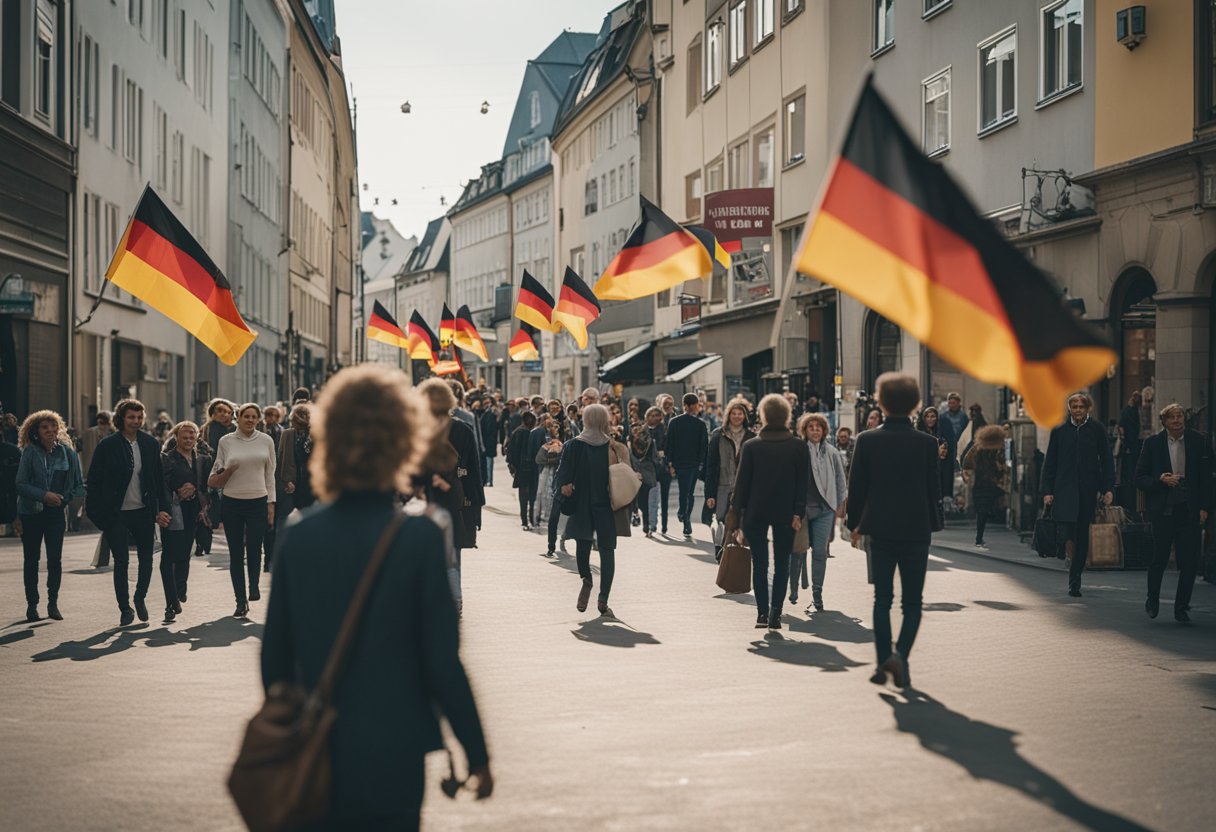In the vibrant city of Berlin, the capital of Germany, the predominant language spoken is German. This is not just any form of German, but the standard variation known as ‘Hochdeutsch’ or High German, which is the codified standard for how the language is taught in schools and used in the media throughout the country.
This form of German is understood by all and is the version of the language in Berlin you will encounter in official settings and among people throughout the various regions of Germany.
That said, Berlin is also known for its unique dialect, Berlinerisch, which bears strong ties to High German but includes an array of distinct expressions and linguistic quirks. Berlinerisch is often perceived as a marker of local identity, reflecting the city’s historical division and the diverse influences that have shaped its current linguistic landscape.
Despite German being the main language, English is widely spoken in Berlin, especially in the tourism sector, business, and by younger generations. Most residents have a good command of English, allowing for easy communication with international visitors. However, an effort to speak the German language is always appreciated by the locals.
Official Language in Berlin
Berlin, the capital city of Germany, functions primarily in the German language. This section provides a focused examination of the language’s usage in the city, covering its general traits, variations, and the unique influences from Berlin itself.
German Language Overview
The German language, referred to as “Deutsch” in the native lexicon, is a West Germanic language that is notably characterized by its complex grammatical structures.
It uses the Latin script and is recognized for the High German consonant shift, which distinguishes it from other Germanic languages. German vocabulary is known for its precision and extensive compounding, which allows the creation of specific terms and concepts.
Standard German and Dialects
Standard German, or Hochdeutsch, is the written and spoken form of the language used in formal contexts across Germany, including Berlin. It became the predominant form of the language following the need for a standardized writing system and grammar for administration and education.
Despite the prevalence of Standard German, a range of German dialects coexist, reflecting historical and regional linguistic variations. These dialects exhibit unique phonological and grammatical traits that can differ quite significantly from the standardized form.
Influence of Berlin on German Language
Berlin has its own regiolect, known as Berlinerisch or Berlin German, which has influenced and been influenced by the Standard German.
Berlin’s vocabulary and phonology have shaped the German language, presenting a variant that carries a distinct urban and cosmopolitan identity. The city’s dynamic linguistic landscape reflects its complex history and diverse population, contributing to the evolution of the German language.
Multilingualism in Berlin
Berlin, a city characterized by its rich diversity, is a linguistic tapestry woven with various languages. While the official language is German, the metropolis thrives on the vibrant presence of several immigrant languages and the widespread use of foreign languages in public domains.
Immigrant Language in Berlin
Berlin is home to a vast number of immigrants, and as a result, a multitude of languages resonate through its streets. A significant portion of the population speaks Turkish, given the large Turkish community. Other prevalent immigrant languages include Arabic, Russian, Polish, Kurdish, and Vietnamese.
These languages not only serve as a means of communication but also as a cultural link for Berlin’s diverse communities. Households with immigrant backgrounds often converse in their languages of origin, maintaining the linguistic heritage within families.
Public Utilization of Foreign Languages
The widespread use of foreign languages is evident in Berlin’s public sphere. English is commonly spoken, particularly in the realms of business, technology, and tourism, making it a quasi-secondary language in the city.
Institutions and services cater to the multilingual population by providing information and assistance in various foreign languages. Additional languages like Spanish, French, and Italian are also frequently heard, reflecting the cosmopolitan nature of Berlin’s populace.
Notably, the city’s educational system promotes multilingualism, offering programs in different languages and fostering successive generations of multilingual speakers.
Regional and Minority Language in Berlin
While German is the predominant language spoken in Berlin, the city is also rich in linguistic diversity, acknowledging a variety of regional and minority languages. These languages are supported by the European Charter for Regional or Minority Languages and have unique cultural significance in Germany.
Recognized Minority Languages
Recognized minority languages in Germany include Danish, Low German, Frisian, Sorbian, and Romani. These languages are officially protected and supported, particularly in regions where minority communities are concentrated.
For instance, the Danish minority in Germany enjoys special protections, and the language is maintained through schools and cultural institutions. Similarly, the Sorbian language, with its two forms, Upper and Lower Sorbian, is spoken by the Sorbian community and receives support for its continual use and preservation.
The Romani language has seen recognition as well, reflecting the cultural heritage of the German Sinti and Roma.
Regional Language Varieties
Apart from officially recognized minority languages, Germany is home to various regional language varieties. These include but are not limited to Bavarian, Central German, and Limburgish, representing the linguistic diversity present within different German regions.
In the north, varieties such as North Frisian and Saterland Frisian are spoken by smaller communities and have their respective cultural significance.
Moreover, languages like French, Spanish, Dutch, and Italian are also present among the Berlin population due to the international character of the city. These languages, while not official minority languages, contribute to the multilingual fabric of Berlin.
Language and Cultural Identity
The interplay of language and cultural identity in Berlin is prominently characterized by a diverse population that embraces both the tradition of the Germanic tongue and the cosmopolitan nature of its people.
Language in the Cultural Fabric of Berlin
Berlin, the capital city of Germany, showcases a rich tapestry of linguistic diversity within its cultural framework. Rooted in a West Germanic heritage, the predominant language is German, spoken by the majority of the populace.
Within the realm of German, several dialects emerge, including the distinct Berlin dialect, known as Berlinerisch or Berlinisch. This regiolect is a variant of the broader West Germanic language and is particularly noted for containing elements of Missingsch, a blend of Low German (Niederdeutsch) and High German (Hochdeutsch).
Berlin’s multicultural environment, contributed to by waves of immigration, enriches the city’s linguistic landscape.
Languages such as Turkish, Arabic, Russian, Polish, and Italian are also widely encountered, reflecting the pluralistic nature of Berlin’s demographics. The Goethe Institut plays a significant role in fostering Germanic culture and promoting linguistic assimilation among the population.
In everyday life, phrases such as “hello” (hallo), “thanks” (danke), and “yes” (ja) are common in interactions, indicative of a culture that values courtesy.
Despite the prevalence of German, a significant portion of the city’s inhabitants and visitors leverage English for communication, particularly in business, academia, and tourism, underscoring Berlin’s status as a global city.
Language Education and Institutions
In Berlin, language education caters extensively to both immigrants and native speakers, focusing on integration and fluency in German, the official language.
German Language Education for Immigrants and Speakers of Foreign Languages
For immigrants arriving in Berlin, learning German is vital for integration and employment. Recognized institutions like the Goethe-Institut offer a range of German language courses.
These include standard language classes aimed at helping learners achieve fluency and comprehension required to navigate daily life in the city. Often these courses may be accessed for a fee; however, there are initiatives that offer language education for free or at a reduced cost, especially for new immigrants.
According to Eurostat, language competency is a core element of successful immigration. Therefore, the German government has put in place integration courses, which include language instruction to help non-native speakers become proficient in German. These courses not only teach language skills but also provide insights into the culture and legal system in Germany.
While German is the predominant language spoken in Berlin, the city’s global orientation means that English is also widely understood, especially in business and tourist areas. English-speaking expatriates and travelers will find that they can communicate effectively in most situations, although a basic knowledge of German can be beneficial for deeper cultural immersion.
Historical and Geopolitical Influence
Berlin’s linguistic landscape is profoundly shaped by its history and geopolitical changes. Language in the city reflects shifts in power, migrations, and cultural dynamics over centuries.
Germany and Berlin’s Historical Impact on Language
Historically, the region of Brandenburg and Saxony have been centers of power where the German language evolved and proliferated.
The German language area encompassed not only present-day Germany but also parts of Austria and Switzerland, thus influencing the linguistic practices in Southern Germany and beyond.
In Central Germany, variations of German began taking form, with places like Hamburg and Munich developing their own dialects.
Berlin dialect, also known as Berliner Schnauze, evolved in the capital region. While Berlin became a melting pot of cultures and languages, traditional dialects like Northern Low Saxon and Upper Sorbian were spoken in their respective areas, highlighting Germany’s regional diversity.
The Yiddish language, too, had a presence, particularly resonant near the historic Brandenburg Gate due to the significant Jewish community.
Modern Influence and European Union Languages
In modern times, the influence of the European Union (EU) and Berlin’s status as a global city have diversified the linguistic environment.
The rank of German as a widely spoken language in the EU has encouraged the presence of other European languages, including Balkan languages, as part of the city’s fabric. This reflects Berlin’s role as a hub for international dialogue and a destination for expatriates from across Europe.
The question of what language is spoken in Berlin Germany can also be addressed by considering its international population. Today, in addition to German, English is commonly used, serving as a lingua franca in business and tourism.
This bilingual exchange is an outcome of economic dynamics, particularly when discussing the technology sector, where English proficiency is often essential.
Frequently Asked Questions
Germany is recognized for its linguistic diversity, and Berlin, as its capital city, reflects this multilingual tapestry. With a dynamic and international population, the city’s language landscape offers a fascinating glimpse into its culture and communication.
How many languages are spoken in Germany?
In addition to the 23 officially recognized languages in the European Union, within its borders, Germany fosters a multitude of languages due to its diverse population that includes numerous immigrant communities.
What is the predominant language spoken in Berlin?
The official and most widely spoken language in Berlin is German. While the Berliner dialect, known as Berlinerisch, has its own unique features, Standard German is used in schools, media, and formal settings.
Are multiple languages widely used in Berlin, and if so, what are they?
Besides German, several other languages are frequently used in Berlin. These include Turkish, Arabic, Russian, Polish, and Italian, reflecting the city’s diverse population.
Is English widely understood and spoken in Berlin?
English is understood and spoken to a reasonable extent in Berlin, especially among the younger population, in the tourism sector, and within business environments.
What is the linguistic relationship between Berlin and the rest of Germany?
Berlin’s linguistic practices largely mirror the broader trends in Germany, with Standard German being the norm. However, the city’s dialect and diverse migrant languages add to the linguistic landscape, making it distinctive.
Can visitors to Berlin get by with English, or is German necessary?
Visitors can usually get by with English in Berlin, particularly in tourist areas and among younger people. Nonetheless, learning some German phrases or taking German classes can enhance the travel experience and is appreciated by locals.





